仅用学习参考

目标
- 列表
- 元组
- 字典
- 字符串
- 公共方法
- 变量高级
知识点回顾
- Python 中数据类型可以分为数字型和非数字型
- 数字型
- 整型 (int)
- 浮点型(float)
- 布尔型(bool)
- 真True非 0 数 ——非零即真
- 假False0
- 复数型 (complex)
- 主要用于科学计算,例如:平面场问题、波动问题、电感电容等问题
- 非数字型
- 字符串
- 列表
- 元组
- 字典
- 在Python 中,所有非数字型变量都支持以下特点:
01. 列表
1.1 列表的定义
- List(列表) 是 Python 中使用 最频繁 的数据类型,在其他语言中通常叫做 数组
- 专门用于存储一串 信息
- 列表用[] 定义,数据 之间使用 , 分隔
- 列表的索引 从 0 开始
- 索引就是数据在列表中的位置编号,索引又可以被称为下标
注意:从列表中取值时,如果 超出索引范围,程序会报错
In [33]: smoke_list = ["蓝利群", "芙蓉王", "万宝路"]
In [34]: for smoke in smoke_list:
...: print smoke
...:
蓝利群
芙蓉王
万宝路
In [35]:
In [35]: print smoke_list[0]
蓝利群
In [36]: print smoke_list[1]
芙蓉王
In [37]: print smoke_list[2]
万宝路
In [38]: print smoke_list[3]
---------------------------------------------------------------------------
IndexError Traceback (most recent call last)
<ipython-input-38-53890986dcdc> in <module>()
----> 1 print smoke_list[3]
IndexError: list index out of range
In [39]:
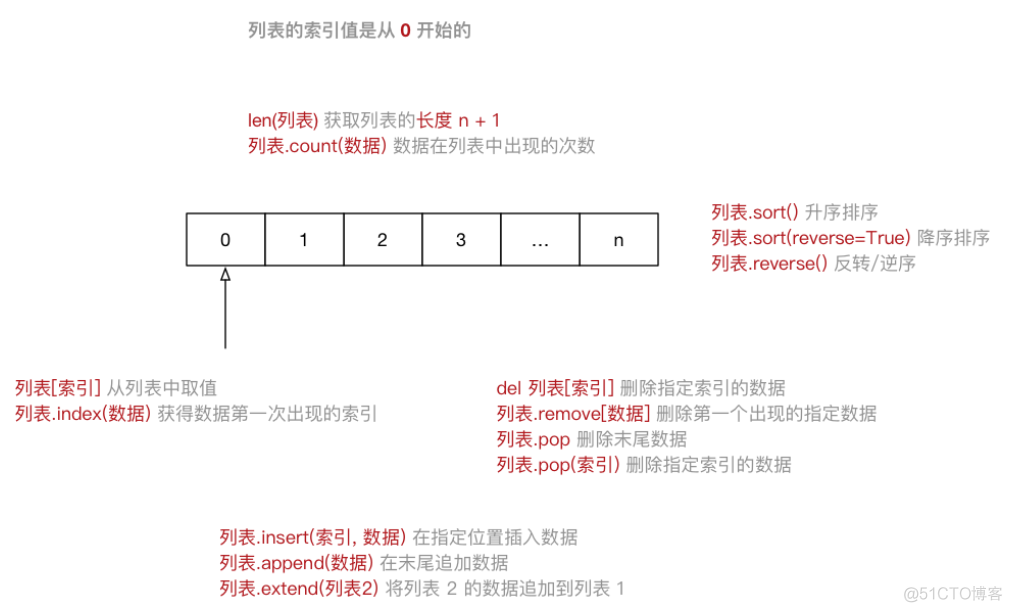
按照图片的函数执行一下看看:
In [40]: len(smoke_list)Out[40]: 3
In [41]: smoke_list.count("蓝利群")
Out[41]: 1
In [42]:
In [44]: smoke_list.sort()
In [45]: for smoke in smoke_list:
...: print smoke
...:
万宝路
芙蓉王
蓝利群
In [46]:
In [46]: smoke_list.sort(reverse=True)
In [47]: for smoke in smoke_list:
...: print smoke
...:
蓝利群
芙蓉王
万宝路
In [48]:
In [48]: smoke_list.reverse()
In [49]: for smoke in smoke_list:
...: print smoke
...:
万宝路
芙蓉王
蓝利群
In [50]:
In [50]: smoke_list.insert(1,"黄金龙")
In [51]: for smoke in smoke_list:
...: print smoke
...:
万宝路
黄金龙
芙蓉王
蓝利群
In [52]:
In [52]: smoke_list.append("王者农药")
In [53]: for smoke in smoke_list:
...: print smoke
...:
万宝路
黄金龙
芙蓉王
蓝利群
王者农药
In [54]:
In [54]: smoke_list2 = ["胖哥槟榔"]
In [55]: smoke_list.extend(smoke_list2)
In [56]: for smoke in smoke_list:
...: print smoke
...:
万宝路
黄金龙
芙蓉王
蓝利群
王者农药
胖哥槟榔
In [57]:
In [57]: del smoke_list[1]
In [58]: for smoke in smoke_list:
...: print smoke
...:
万宝路
芙蓉王
蓝利群
王者农药
胖哥槟榔
In [59]:
In [61]: smoke_list.remove("蓝利群")
In [62]: for smoke in smoke_list:
...: print smoke
...:
万宝路
芙蓉王
王者农药
胖哥槟榔
In [63]:
In [63]: smoke_list.pop()
Out[63]: '\xe8\x83\x96\xe5\x93\xa5\xe6\xa7\x9f\xe6\xa6\x
94'
In [64]: smoke_list.pop
Out[64]: <function pop>
In [65]: smoke_list.pop()
Out[65]: '\xe7\x8e\x8b\xe8\x80\x85\xe5\x86\x9c\xe8\x8d\x
af'
In [66]: for smoke in smoke_list:
...: print smoke
...:
万宝路
芙蓉王
In [67]: smoke_list.pop(0)
Out[67]: '\xe4\xb8\x87\xe5\xae\x9d\xe8\xb7\xaf'
In [68]: for smoke in smoke_list:
...: print smoke
...:
芙蓉王
In [69]:
02. 元组
2.1 元组的定义
- Tuple(元组)与列表类似,不同之处在于元组的元素不能修改
- 元组表示多个元素组成的序列
- 元组在Python 开发中,有特定的应用场景
- 用于存储一串 信息,数据之间使用, 分隔
- 元组用() 定义
- 元组的索引从0 开始
- 索引就是数据在元组中的位置编号
In [70]: print smoke_tuple
('\xe8\x93\x9d\xe5\x88\xa9\xe7\xbe\xa4', '\xe4\xb8\x87\x
e5\xae\x9d\xe8\xb7\xaf', '\xe8\x8a\x99\xe8\x93\x89\xe7\x
8e\x8b')
创建空元组
smoke_tuple = ()元组中 只包含一个元素 时,需要 在元素后面添加逗号
smoke_tuple = ("蓝利群", )
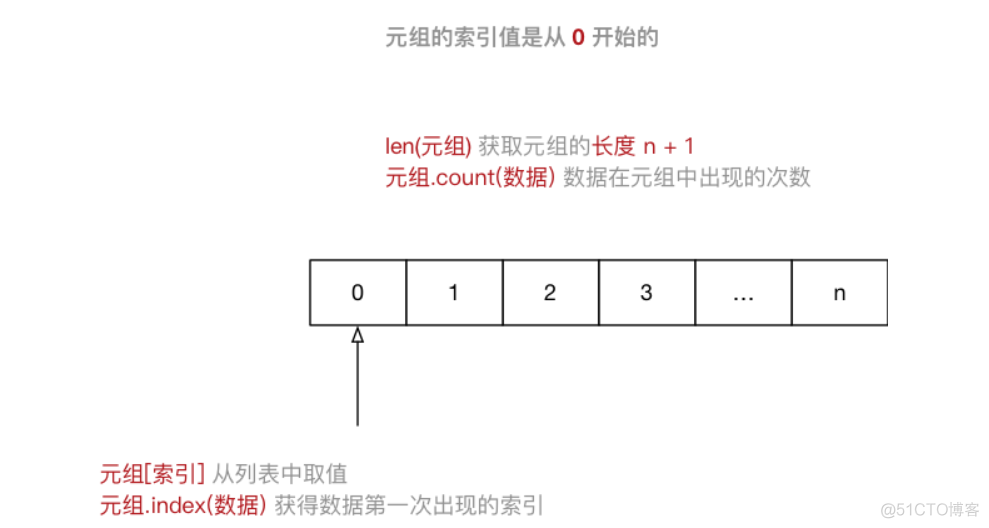
Out[71]: 3
In [73]: smoke_tuple.count("蓝利群")
Out[73]: 1
In [73]: smoke_tuple.count("蓝利群")
Out[73]: 1
In [74]: print smoke_tuple[0]
蓝利群
In [75]: print smoke_tuple.index("万宝路")
1
In [76]:
In [76]: for smoke in smoke_tuple:
...: print smoke
...:
蓝利群
万宝路
芙蓉王
In [77]:
元组和列表之间的转换
- 使用list 函数可以把元组转换成列表
In [80]: type(smoke_tuple)
Out[80]: tuple
In [81]: smoke_tuple = list(smoke_tuple)
In [82]: type(smoke_tuple)
Out[82]: list
- 使用tuple 函数可以把列表转换成元组
In [83]: type(smoke_tuple)
Out[83]: list
In [84]: smoke_tuple = tuple(smoke_tuple)
In [85]: type(smoke_tuple)
Out[85]: tuple
03. 字典
3.1 字典的定义
- dictionary(字典) 是 除列表以外 Python 之中 最灵活 的数据类型
- 字典同样可以用来存储多个数据
- 通常用于存储描述一个 物体 的相关信息
- 和列表的区别
- 列表 是 有序 的对象集合
- 字典 是 无序 的对象集合
- 字典用{} 定义
- 字典使用键值对 存储数据,键值对之间使用 , 分隔
- 键 key 是索引
- 值 value 是数据
- 键 和 值 之间使用 : 分隔
- 键必须是唯一的
- 值 可以取任何数据类型,但 键 只能使用 字符串、数字或 元组
...: 王":26}
In [88]: print smoke_dict
{'\xe8\x8a\x99\xe8\x93\x89\xe7\x8e\x8b': 26, '\xe4\xb8\x
87\xe5\xae\x9d\xe8\xb7\xaf': 18, '\xe8\x93\x9d\xe5\x88\x
a9\xe7\xbe\xa4': 17.5}
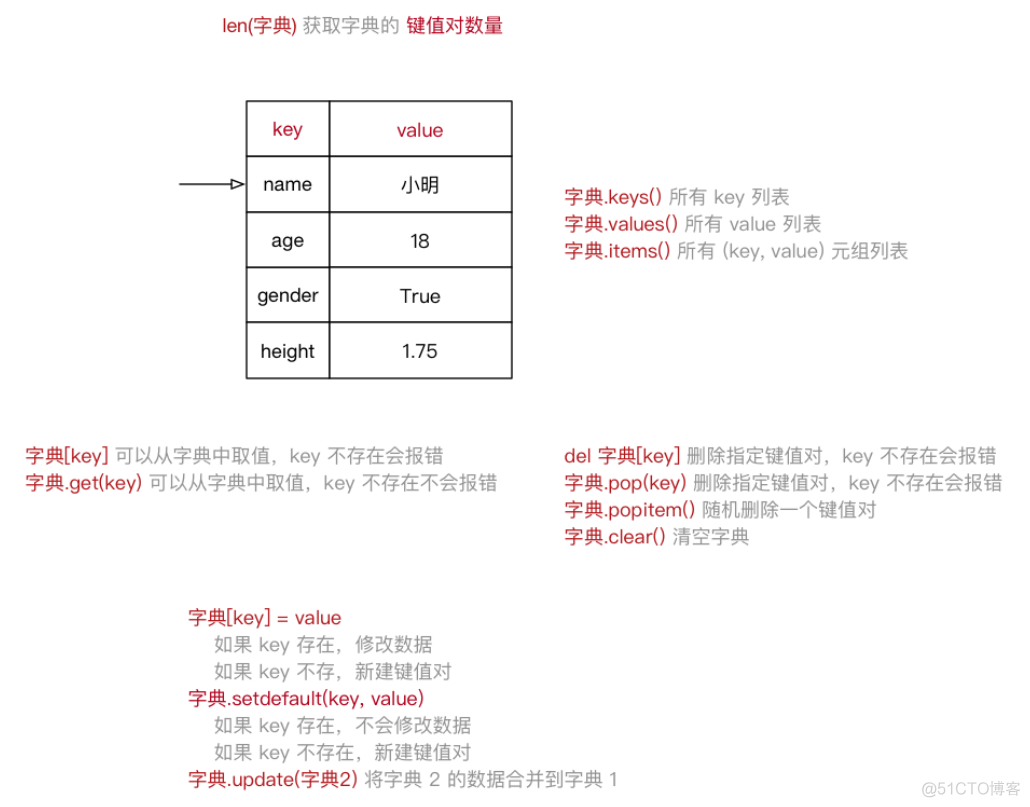
Out[89]: 3
In [90]: print smoke_dict[4]
--------------------------------------------------------
KeyError Traceback (most recent call last)
<ipython-input-90-9a992459c2af> in <module>()
----> 1 print smoke_dict[4]
KeyError: 4
In [91]: print smoke_dict.get(4)
None
In [92]:
In [93]: for key in smoke_dict:
...: print("key = %s, value = %s " % (key,smoke_dict[key]))
...:
...:
key = 芙蓉王, value = 26
key = 万宝路, value = 18
key = 蓝利群, value = 17.5
04. 字符串
4.1 字符串的定义
- 字符串就是一串字符,是编程语言中表示文本的数据类型
- 在 Python 中可以使用一对双引号" 或者一对单引号' 定义一个字符串
- 虽然可以使用\" 或者\' 做字符串的转义,但是在实际开发中:
- 如果字符串内部需要使用",可以使用' 定义字符串
- 如果字符串内部需要使用',可以使用" 定义字符串
- 可以使用索引获取一个字符串中指定位置的字符,索引计数从0开始
- 也可以使用for循环遍历字符串中每一个字符
大多数编程语言都是用 " 来定义字符串
In [94]: string = "Hello Python"
...:
...: for c in string:
...: print(c)
...:
H
e
l
l
o
P
y
t
h
o
n
In [95]:
In [95]: string = "胖子老板,吃饭了没有呀"
...:
...: for c in string:
...: print(c)
...:
�
�
�
In [96]:
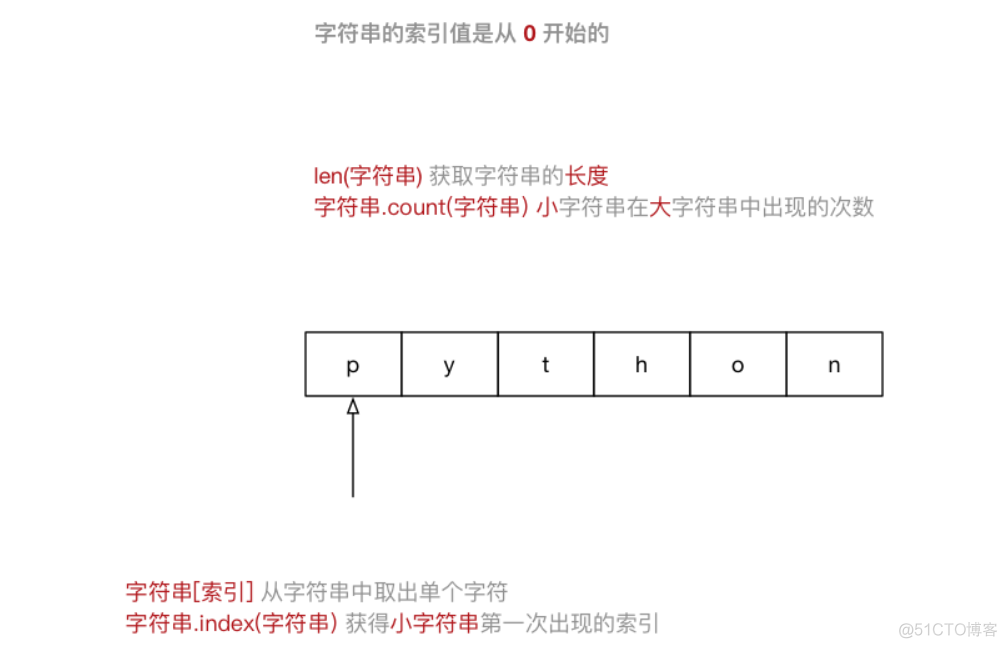
In [97]: len(string1)
Out[97]: 14
In [98]: string1.count("l")
Out[98]: 2
In [99]: string1[0]
Out[99]: 'h'
In [100]: string1.index("l")
Out[100]: 2
In [101]:
4.2 字符串的常用操作
- 在ipython3 中定义一个字符串,例如:hello_str = ""
- 输入hello_str. 按下TAB 键,ipython 会提示字符串能够使用的方法如下:
hello_str.capitalize hello_str.isidentifier hello_str.rindex
hello_str.casefold hello_str.islower hello_str.rjust
hello_str.center hello_str.isnumeric hello_str.rpartition
hello_str.count hello_str.isprintable hello_str.rsplit
hello_str.encode hello_str.isspace hello_str.rstrip
hello_str.endswith hello_str.istitle hello_str.split
hello_str.expandtabs hello_str.isupper hello_str.splitlines
hello_str.find hello_str.join hello_str.startswith
hello_str.format hello_str.ljust hello_str.strip
hello_str.format_map hello_str.lower hello_str.swapcase
hello_str.index hello_str.lstrip hello_str.title
hello_str.isalnum hello_str.maketrans hello_str.translate
hello_str.isalpha hello_str.partition hello_str.upper
hello_str.isdecimal hello_str.replace hello_str.zfill
hello_str.isdigit hello_str.rfind
提示:正是因为 python 内置提供的方法足够多,才使得在开发时,能够针对字符串进行更加灵活的操作!应对更多的开发需求!
1) 判断类型 - 9
方法
说明
string.isspace()
如果 string 中只包含空格,则返回 True
string.isalnum()
如果 string 至少有一个字符并且所有字符都是字母或数字则返回 True
string.isalpha()
如果 string 至少有一个字符并且所有字符都是字母则返回 True
string.isdecimal()
如果 string 只包含数字则返回 True,全角数字
string.isdigit()
如果 string 只包含数字则返回 True,全角数字、⑴、\u00b2
string.isnumeric()
如果 string 只包含数字则返回 True,全角数字,汉字数字
string.istitle()
如果 string 是标题化的(每个单词的首字母大写)则返回 True
string.islower()
如果 string 中包含至少一个区分大小写的字符,并且所有这些(区分大小写的)字符都是小写,则返回 True
string.isupper()
如果 string 中包含至少一个区分大小写的字符,并且所有这些(区分大小写的)字符都是大写,则返回 True
2) 查找和替换 - 7
方法
说明
string.startswith(str)
检查字符串是否是以 str 开头,是则返回 True
string.endswith(str)
检查字符串是否是以 str 结束,是则返回 True
string.find(str, start=0, end=len(string))
检测 str 是否包含在 string 中,如果 start 和 end 指定范围,则检查是否包含在指定范围内,如果是返回开始的索引值,否则返回 -1
string.rfind(str, start=0, end=len(string))
类似于 find(),不过是从右边开始查找
string.index(str, start=0, end=len(string))
跟 find() 方法类似,不过如果 str 不在 string 会报错
string.rindex(str, start=0, end=len(string))
类似于 index(),不过是从右边开始
string.replace(old_str, new_str, num=string.count(old))
把 string 中的 old_str 替换成 new_str,如果 num 指定,则替换不超过 num 次
3) 大小写转换 - 5
方法
说明
string.capitalize()
把字符串的第一个字符大写
string.title()
把字符串的每个单词首字母大写
string.lower()
转换 string 中所有大写字符为小写
string.upper()
转换 string 中的小写字母为大写
string.swapcase()
翻转 string 中的大小写
4) 文本对齐 - 3
方法
说明
string.ljust(width)
返回一个原字符串左对齐,并使用空格填充至长度 width 的新字符串
string.rjust(width)
返回一个原字符串右对齐,并使用空格填充至长度 width 的新字符串
string.center(width)
返回一个原字符串居中,并使用空格填充至长度 width 的新字符串
5) 去除空白字符 - 3
方法
说明
string.lstrip()
截掉 string 左边(开始)的空白字符
string.rstrip()
截掉 string 右边(末尾)的空白字符
string.strip()
截掉 string 左右两边的空白字符
6) 拆分和连接 - 5
方法
说明
string.partition(str)
把字符串 string 分成一个 3 元素的元组 (str前面, str, str后面)
string.rpartition(str)
类似于 partition() 方法,不过是从右边开始查找
string.split(str="", num)
以 str 为分隔符拆分 string,如果 num 有指定值,则仅分隔 num + 1 个子字符串,str 默认包含 '\r', '\t', '\n' 和空格
string.splitlines()
按照行('\r', '\n', '\r\n')分隔,返回一个包含各行作为元素的列表
string.join(seq)
以 string 作为分隔符,将 seq 中所有的元素(的字符串表示)合并为一个新的字符串
4.3 字符串的切片
- 切片方法适用于字符串、列表、元组
- 切片使用索引值来限定范围,从一个大的字符串中切出小的字符串
- 列表和元组都是有序的集合,都能够通过索引值获取到对应的数据
- 字典是一个无序的集合,是使用键值对保存数据
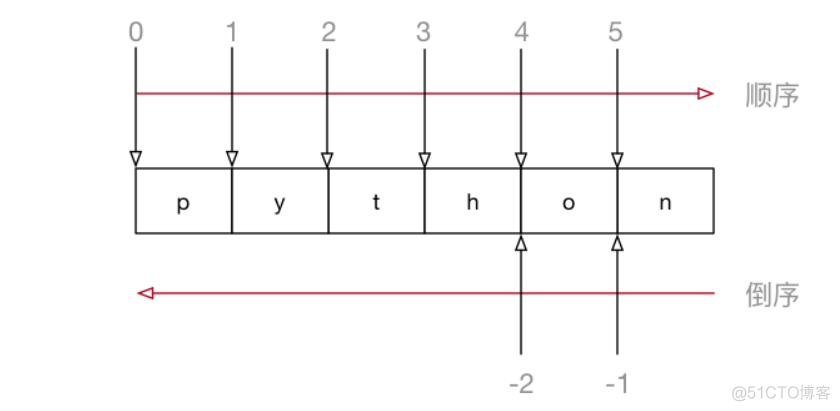
In [102]: string2 = string1[0:3:1]
In [103]: print string2
hel
In [104]: print string1[1:3:2]
e
In [105]:
注意:
- 从起始 位开始,到结束位的前一位结束(不包含结束位本身)
索引的顺序和倒序
- 在 Python 中不仅支持顺序索引,同时还支持倒序索引
- 所谓倒序索引就是从右向左计算索引
- 最右边的索引值是-1,依次递减
演练需求
答案
num_str = "0123456789"# 1. 截取从 2 ~ 5 位置 的字符串
print(num_str[2:6])
# 2. 截取从 2 ~ `末尾` 的字符串
print(num_str[2:])
# 3. 截取从 `开始` ~ 5 位置 的字符串
print(num_str[:6])
# 4. 截取完整的字符串
print(num_str[:])
# 5. 从开始位置,每隔一个字符截取字符串
print(num_str[::2])
# 6. 从索引 1 开始,每隔一个取一个
print(num_str[1::2])
# 倒序切片
# -1 表示倒数第一个字符
print(num_str[-1])
# 7. 截取从 2 ~ `末尾 - 1` 的字符串
print(num_str[2:-1])
# 8. 截取字符串末尾两个字符
print(num_str[-2:])
# 9. 字符串的逆序(面试题)
print(num_str[::-1])
05. 公共方法
5.1 Python 内置函数
Python 包含了以下内置函数:
函数
描述
备注
len(item)
计算容器中元素个数
del(item)
删除变量
del 有两种方式
max(item)
返回容器中元素最大值
如果是字典,只针对 key 比较
min(item)
返回容器中元素最小值
如果是字典,只针对 key 比较
cmp(item1, item2)
比较两个值,-1 小于/0 相等/1 大于
Python 3.x 取消了 cmp 函数
注意
- 字符串比较符合以下规则: "0" < "A" < "a"
5.2 切片
描述
Python 表达式
结果
支持的数据类型
切片
"0123456789"[::-2]
"97531"
字符串、列表、元组
- 切片使用索引值来限定范围,从一个大的字符串中切出小的字符串
- 列表和元组都是有序的集合,都能够通过索引值获取到对应的数据
- 字典是一个无序的集合,是使用键值对保存数据
5.3 运算符
运算符
Python 表达式
结果
描述
支持的数据类型
+
[1, 2] + [3, 4]
[1, 2, 3, 4]
合并
字符串、列表、元组
*
["Hi!"] * 4
['Hi!', 'Hi!', 'Hi!', 'Hi!']
重复
字符串、列表、元组
in
3 in (1, 2, 3)
True
元素是否存在
字符串、列表、元组、字典
not in
4 not in (1, 2, 3)
True
元素是否不存在
字符串、列表、元组、字典
> >= == < <=
(1, 2, 3) < (2, 2, 3)
True
元素比较
字符串、列表、元组
注意
- in 在对字典操作时,判断的是字典的键
- in 和not in 被称为成员运算符
成员运算符
成员运算符用于 测试 序列中是否包含指定的 成员
运算符
描述
实例
in
如果在指定的序列中找到值返回 True,否则返回 False
3 in (1, 2, 3) 返回 True
not in
如果在指定的序列中没有找到值返回 True,否则返回 False
3 not in (1, 2, 3) 返回 False
注意:在对 字典 操作时,判断的是 字典的键
5.4 完整的 for 循环语法
- 在Python 中完整的for 循环 的语法如下:
循环体代码
else:
没有通过 break 退出循环,循环结束后,会执行的代码
应用场景
- 在迭代遍历嵌套的数据类型时,例如一个列表包含了多个字典
- 需求:要判断 某一个字典中 是否存在 指定的 值
- 如果存在,提示并且退出循环
- 如果不存在,在循环整体结束后,希望得到一个统一的提示
{"name": "阿土",
"age": 20,
"gender": True,
"height": 1.7,
"weight": 75.0},
{"name": "小美",
"age": 19,
"gender": False,
"height": 1.6,
"weight": 45.0},
]
find_name = "阿土"
for stu_dict in students:
print(stu_dict)
# 判断当前遍历的字典中姓名是否为find_name
if stu_dict["name"] == find_name:
print("找到了")
# 如果已经找到,直接退出循环,就不需要再对后续的数据进行比较
break
else:
print("没有找到")
print("循环结束")

关注微信公众号,回复【资料】、Python、PHP、JAVA、web,则可获得Python、PHP、JAVA、前端等视频资料。
